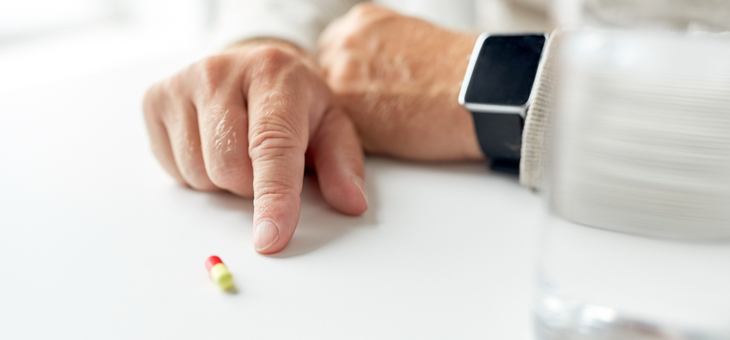In 1946, hard-bitten crime-fighter Dick Tracy began using a two-way wristwatch radio, thwarting fiendish crims like Flattop Jones and Mumbles with forensic nous and technological brilliance.
In 2020, engineers at the UCLA Samueli School of Engineering and the Stanford School of Medicine have created a customised smartwatch that tracks drug levels inside the body in real time by analysing sweat.
It could create a personalised approach to medicine, in which an “ideal drug and dosages can be tailored to an individual” in the fight against heinous villains such as diabetes and heart disease.
Dick Tracy is a cartoon character, but his fictional wristwatch innovation inspired the eventual invention of the smartphone and later smartwatches. That in turn inspired the medical smartwatch innovators, who were excited by the “powerful data-collection, computation and transmission capabilities” of existing smartwatches and wearable tech.
A double-sided adhesive film placed on the underside of the smartwatch is the breakthrough.
“The side of the film that touches the skin records the amount of metabolism-related chemicals present in sweat droplets,” explains studyfinds.org.
“Then, the opposite side of the film transmits this information to the watch. The data is then displayed on the smartwatch or using an app on a smartphone.”
The researchers have concluded that the film can accurately detect levels of glucose and lactate, which are crucial in monitoring diabetes and heart disease.
Currently, such efforts rely on blood analysis. UCLA labels these arrangements “inconvenient, time-consuming, invasive and expensive”.
“In general, medications are prescribed with a ‘one-size-fits-all’ approach – drugs are designed and prescribed based on statistical averages of their effectiveness. There are guidelines for factors such as patients’ weight and age. But in addition to these basic differentiators, our body chemistry constantly changes – depending on what we eat and how much we’ve exercised.
“And on top of these dynamic factors, every individual’s genetic makeup is unique and hence responses to medications can vary. This affects how fast drugs are absorbed, take effect and get eliminated from an individual.”
The smartwatch can “track the profile of medication inside the body continuously and non-invasively,” said study leader Sam Emaminejad, an assistant professor of electrical and computer engineering at UCLA.
“This way, we can tailor the optimal dosage and timing of the intake for each individual. And using this personalisation approach, we can improve the efficacy of the therapeutic treatments.”
Prof. Emaminejad is excited by the prospect of making smartwatches ‘biomonitoring platforms’ that could capture data at an unprecedented scale across hundreds of millions of people.
“This thin sensing film that works with a watch shows such a path forward.”
Many drugs are detectable in sweat because of their small molecular size.
“Now we have come up with a solution to upgrade these wearables into health monitoring platforms, enabling them to measure molecular-level information so that they give us a much deeper understanding of what’s happening inside our body in real time,” he said.
The team’s experiment tracked a common pain medication in individuals over a few hours, stimulating sweat glands by applying a small electric current.
This allowed the researchers to detect changes in body chemistry. As different drugs have a unique electrochemical signature, “the sensor can be designed to look for the level of a particular medication at any given time”.
“This technology is a game-changer and a significant step forward for realising personalised medicine,” said study co-author Ronald W. Davis, a professor of biochemistry and genetics at Stanford Medical School.
“Emerging pharmacogenomic solutions, which allow us to select drugs based on the genetic makeup of individuals, have already shown to be useful in improving the efficacy of treatments. So, in combination with our wearable solution, which helps us to optimise the drug dosages for each individual, we can now truly personalise our approaches to pharmacotherapy.”
UCLA believes the innovation is significant because it can “accurately detect a drug’s unique electrochemical signal”, from within signals from other molecules in the body.
“This could be particularly important for individuals with mental health issues, where doctors prescribe them prolonged pharmacotherapy treatments,” said Prof. Emaminejad.
“The patients could benefit from such easy-to-use, non-invasive monitoring tools, while doctors could see how the medication is doing in the patient.”
Little wonder, then, that another study is underway, in which UCLA researchers are collaborating with Apple on a three-year study to see if gadgets can help revolutionise how depression is detected and treated.
“The study aims to measure sleep, physical activity, heart rate, and ‘daily routines’ to see if there is a correlation between them and depression and anxiety,” reports Gizmodo.
“To track those metrics, researchers will utilise an iPhone, Apple Watch, and Beddit, the sleep-monitoring gadget company that Apple acquired in 2017.
“The idea here is that depression and anxiety may be related to physiological changes. In a best-case scenario, researchers would potentially be able to identify the onset of a depressive episode based on a person’s health data, as well as track whether a certain type of treatment is effective.”
Are you ready for your body to be monitored by a wristwatch?
If you enjoy our content, don’t keep it to yourself. Share our free eNews with your friends and encourage them to sign up.
Related articles:
https://www.yourlifechoices.com.au/technology/gadgets/the-future-of-domestic-tech
https://www.yourlifechoices.com.au/technology/gadgets/technology-to-keep-you-independent
https://www.yourlifechoices.com.au/health/your-health/how-to–meditate

